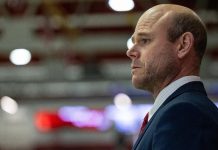Two proposals aimed at easing recruiting restrictions on ice hockey coaches passed at the recent NCAA Convention in Nashville, Tenn.
Propositions 102 and 103 were hockey-only proposals that passed with little difficulty in a vote by school presidents. All presidents were allowed to vote, but, for the most part, only the presidents of hockey-playing schools participated.
Prop. 102 is the more substantial of the two, and passed against the opposition of the NCAA Rules Committee. It allows schools to make one phone call to each prospect from a foreign country during July after their sophomore year of high school.
The proposal doesn’t go into effect until Aug. 1, 1997, which means it will have no impact until July of 1998, for the recruiting year 2000.
The proposal was sponsored by the ECAC and received the overwhelming endorsement and support from the American Hockey Coaches Association.
The NCAA, for the first time, recognized the unique situation in college hockey; that the Canadian Major Junior system provides direct competition to schools. Basketball and football, for example, faces no such competition. Junior age is 16-20, which means many prospective student-athletes are contacted by and committing to major juniors before ever hearing from a U.S. college.
“I endorsed it,” said Yale coach Tim Taylor. “There’s nothing wrong with us letting them know about our system. It’s a step in the right direction.”
The coaches see Prop. 102 as a long-time coming, but convincing school presidents and the NCAA that the idea was not just for self-interest, but also in the best interests of the student-athlete, took some time.
“When you ask coaches, all along they’d like to have 25 phone calls,” said NCAA spokesperson Stephen Mallonee. “But it’s the presidents of the university. And we’re in a mode now of cost reduction and cost-cutting and not unduly bothering the prospects.
“So it’s a little more difficult than you think, and usually the sports that get the breaks are football and basketball.”
Most coaches see this as only the first step. The ability to contact American-born sophomores is also crucial, they say, as the Major Juniors continue to expand their reach further and further south.
“Junior teams can get into their living rooms (early),” Taylor said. “If a 15- or 16-year old is very good, agents go around and say to sign with them. They say it’s a quick ticket to the pros. Nobody tells them they are forfeiting the possibility of a scholarship.”
The NCAA committee was concerned about bothering prospective student-athletes too early, and said that one phone call will not make that much of a difference.
But as one observer noted, “It’s not just one call. If [Miami’s] Mark Mazzoleni calls, and [Boston University’s] Jack Parker calls, and [Michigan State’s] Ron Mason calls, and so on, that will help.”
Prop. 103 allows coaches to have more flexibility with their seven recruiting opportunities. Previously, coaches were restricted to no more than four evaluations (watching a player in a game) and three in-person contacts. The three contacts limit still applies, but coaches may now make up to seven evaluations, as long as the total of contacts and evaluations doesn’t exceed seven in one year.


